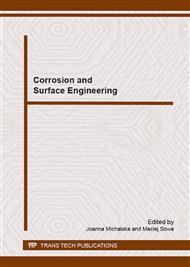p.190
p.194
p.199
p.203
p.207
p.213
p.217
p.221
p.225
Bio-Corrosion of Fibrous Cement Boards and Cement Composites
Abstract:
The paper deals with the comparative study of bio-corrosion of fibrous cement boards and Portland cement composites. Fibre-cement flat boards are widely used materials in the Slovak Republic for exterior and interior cladding, as fibre-cement slates for roofing and cladding and as fibre-cement corrugated sheets for roofing and cladding. Bio-corrosion of studied materials has been simulated in laboratory conditions during 80 days. Effect of sulphur-oxidizing bacteria Acidithiobacillus thiooxidans on the specimens was investigated. The bio-deterioration processes have been manifested by leaching of main cement components as well as by surface changes. The calcium and silicon contents in leachates were evaluated during the experiments using X – ray fluorescence method (XRF). Concluding the results of the concrete’s biodeteriogens influence on the analyzed samples (fiber boards and cement composites) more extensive leaching of calcium ions from the cement matrix was confirmed as assumed by bacteria influence when compared to the abiotic environment. Mixture of white compounds on the samples surface was identified by SEM microscopy and XRD analysis as sulphate products (ettringite, thaumasite, gypsum). Shift of pH of liquid media to alkaline region up to 7.2 due to alkaline products leaching were noticed for all studied samples.
Info:
Periodical:
Pages:
207-210
Citation:
Online since:
January 2015
Keywords:
Price:
Сopyright:
© 2015 Trans Tech Publications Ltd. All Rights Reserved
Share:
Citation:


